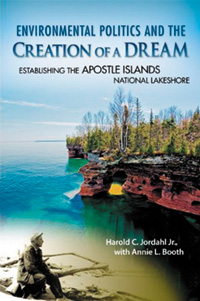Book Smart

Environmental Politics and the Creation of a Dream: Establishing the Apostle Islands National Lakeshore (UW Press, 2011)
Harold C. Jordahl Jr., emeritus professor of Urban and Regional Planning (with Annie L. Booth)
When emeritus professor Arnold Alanen proposed the Wisconsin Land & Life series for UW Press, he envisioned a book that would feature the formation of the Apostle Islands National Lakeshore. Just off the coast of northern Wisconsin in Lake Superior, the 22-island archipelago has long been a favorite destination for tourists and explorers.
In 1970, the same year as the first Earth Day, the Apostle Islands National Lakeshore became a national park thanks to legislation from then-Sen. Gaylord Nelson. Rep. Dave Obey, then at the beginning of his tenure in Congress, played a major role, following in the footsteps of such prominent supporters as President John F. Kennedy and brothers Stewart and Mo Udall.
But the work of Harold Jordahl Jr. (known as Bud) laid the foundation for the long, complex process. Recognizing Jordahl as the one person who could address this complicated topic, Alanen and others strongly encouraged him to do so.
“The work of people such as Bud can never be underestimated,” says Alanen, emeritus professor of landscape architecture and series editor for the UW Press. “Not only did Bud have the necessary academic background to understand natural resource issues, but he had an extraordinary understanding of the legislative process, as well as a remarkable talent in bringing people together to work on a common cause.”
Jordahl began his career as a game manager in Viroqua, then came to UW–Madison as a part-time lecturer after some time in state government. From 1969-89, he taught at UW–Madison full-time, most notably a two-semester seminar in resource policy issues.
Throughout his career, his interdisciplinary view of research and land management set the standard for collaborative work in the outdoors, both on his own property and in the larger natural areas enjoyed by thousands of citizens each year.
“You could say that the vocation and the avocation were the same thing,” says Steve Born, emeritus professor of planning and environmental studies, and a colleague and friend for more than 40 years. “It’s like Bud had a set of tentacles touching resource issues. The ones you always hear about are when he was a staffer for Gaylord. But there’s his work on the Forest Act, or deals with private property owners in the Upper Great Lakes region. He had a pivotal role with students and politicians.”
In the 1940s and ‘50s, the islands – privately and publicly owned – held farms, quarries, logging land and homes. Efforts to consolidate the land for conservation and recreation had fallen short before. As commercial fishing lost its hold on the area, though, tourism became more important.
Jordahl’s book is part memoir, part history. With dozens of photos and personal stories, he describes the backroom discussions, state and tribal negotiations and political maneuvering necessary to finally push the legislation through. It took over a decade for Nelson’s main proposal to come to life, with another 16 years to secure Long Island.
“It’s worthwhile remembering just how difficult it can be to get this going through Congress, but also just how worthwhile it can be to protect these areas,” says co-author Annie Booth, a UW alumna now working at the University of Northern British Columbia. “The Apostle Islands are so vulnerable, both explicitly – through cutbacks – and through things like climate change. That protection needs to be taken into consideration, since it cost so much to secure them.”
The resulting manuscript required extensive editing. Booth joined the project while finishing her dissertation in the early 1990s. Though she looks back on her work with fondness, she recognized the reasons behind Jordahl’s perfectionism.
“This was very personal for Bud,” says Booth. “We had to remove 329 pages to get it into book form, and he fought tooth and nail for every one. It was a critical story – he lived it! – and he wanted to know why each particular section had to come out.”
Just a few weeks after celebrating the 40th anniversary of Earth Day and his final revisions on the book, Jordahl passed away in May 2010. His papers in the State Historical Society represent what Booth considers the entire conservation history of Wisconsin from the 1950s through much of the 1970s.
“There are a lot more stories to be told,” she says. “In 50-60 years, people are going to be looking at Bud kind of like they’re looking at Aldo Leopold. For students or professors looking for topics, there’s a whole history waiting to be written.”
Like Leopold, Jordahl was most comfortable in his jeans and cap, out on the land itself. The Farm, in Richland County, had many parallels to Aldo Leopold’s Shack, several miles to the east. It became a training ground for students and DNR staff, who often found themselves working alongside environmentalists and local hunters.
Mostly, though, it was a gathering place for family and friends – including many people who, like Jordahl himself, turned their love of the land into a lifelong career.
“His imprint on stewardship and public land acquisition, is the ultimate blueprint,” says Born. “He was always a champion of public institutions, education, citizen engagement.
But perhaps the real legacy is the very large array of people whom he worked with, and the way they train others. It goes on and on.”
